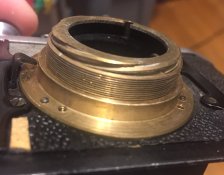I've been thinking about this, and there's no way for me to prove it, but I wonder if this Green Grease was a WWII synthetic formula that was used until petroleum based products became more affordable post-war?
-) To my understanding there was not even a production of synthetic lubricants in Germany in that time.
There would not have been much sense behind it, as first the share of need in volume was negligable compared that of fuel (gasoline), and second as german raw oil was rich on oils apt for the production of lubricants.
-) lubricants based on synthetic oils typically have longer longevity than those based on mineral oils
-) why should Agfa employ postwar lubricants based on synthetic oils which production then would have been more expensive, and with synthetic oil plants all destroyed/dismantled in West-Germany?
I say that because many vegetable oils will "cure" the way linseed oil does when old style oil paint dries. This isn't (mainly) solvent evaporation as with enamel car paint; rather, this is oxidation induce crosslinking of the molecular chains in the oil -- and it's something that seems tied specifically to linoleic acid.
It wouldn't surprise me in the least if Agfa and one or more Japanese camera makers continued to use vegetable based lubricants well into the 1950s -
All lubricant based on hydrocarbon oils tend to oxidize and finally even polymerize.
But yes, the effect is strongest with lineseed. (Of course a effect employed in art, but also anyone who ever used biodegradable lubricant will know that.)
One might argue that in the very first postwar years vegatibile oils were cheaper/more eays to obtain, but Agfa used that green stuff even later.











